Have you ever looked at the beginning of a nonfiction book? A variety of pages preceed the first chapter, but does your book need or want to include them all? Today, Jay Artale (@BirdsOAFpress), a digital nomad and full-time writer and blogger, takes a close look at each type of front matter to help you decide.
Are you confused about what front matter to include in the front of your nonfiction book? You’ve got a few choices, and you want to pick carefully. Readers often expect to find specific bits of information in the first pages of your book, so getting this right can help your book succeed.
If the term “front matter” is unfamiliar to you, here’s a simple definition: Front matter is the pages, such as the title page and preface, that precede the main text of a book.
Always bear your reader in mind when compiling your front matter, they’re creatures of habit and expect a certain level of consistency. So if you want to create a professional-looking book, it’s best to adhere to industry standards and guidelines.
Below, I’ve listed the different front-matter pages in the order they should appear. Also, I’ve included a note to show whether they’re a must-have, recommended, or optional.
Title Page
- Recommended for print books and optional for ebooks.
A basic title page can include your book title, sub-title, and your author name. But some authors also include the name and location of the publisher, the publication year, and edition number. If you don’t put these extra elements on your title page, include them on your copyright page instead. That way you keep your title page simple and clutter-free. You’ll often see an illustration or image incorporated into the title page, but it isn’t necessary.
Copyright Page
- Must have for print and ebooks.
At a minimum, your page should include the copyright year and your author name, e.g., Copyright 2019, Jay Artale, or © 2019 Jay Artale. If you feel uncertain about what to put on your copyright page, check out these copyright examples you can cut and paste into your book.
Dedication Page
- Optional
A dedication is usually a short personal acknowledgment to a family member or friend. It should be short and to the point and recognize a key influence in or supporter of your work or author journey. You can just use their name, e.g., For Neale, or add a personal note, e.g., For Neale, for believing in me. Alternatively, you can write a dedication to a group of people, e.g., For every blogger who wants to become an author.
Look at this Book Dedications Pinterest board for some inspiration. If you’re struggling to come up with a dedication, just leave it out. Don’t force one upon your reader’s if it means nothing.
Epigraph Page
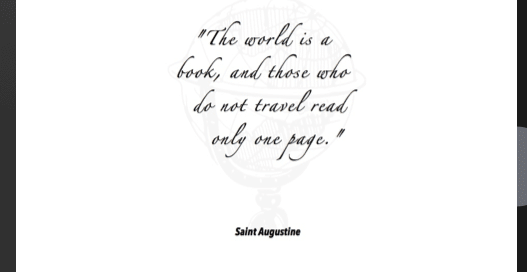
- Optional
If you include a quote, make sure it plays a role and provides your reader with some value. It should support the theme or mood of your book and prepare your readers by setting the content’s tone. Decide whether you want to inspire, inform, entertain, amuse, or provoke your reader, and then search for a quote that fits the bill.
I usually use Brainy Quote to source my quotes. Don’t forget to attribute your quotes to the original source. And if you have a quote in mind but are unsure who said it, you can use the Quote Investigator website.
Quotes can be really impactful in nonfiction books. If you end up with a list of quotes you want to use, choose the most effective one for your front-matter, and use the rest at the start of each of your chapters.
Marketing Page
Amazon shows about 5% of your ebook and 10% of your print book using their Look Inside feature. This content preview is an ideal opportunity to include a promotional page to showcase your other books or include a link to sign up for your mailing list and receive bonus content or a free book. There’s no hard and fast rule for where to insert this marketing page in your front-matter, but the optimal location is after your copyright page and before your table of contents.
Amazon Tip: If you have a big front-matter section and you want more of your book to be available in your preview, email Amazon and request an increase. Provide them with the book details and the requested percentage, which has to be in 5% increments.
Table of Contents
- Must have for print and ebooks
Your writing software should be able to auto-generate a table of contents, but if it doesn’t you need to invest the time to create one manually. At a very minimum, list each chapter in your table. If you’re writing a lengthy book that covers a topic in depth, dropping down to a greater level of detail, e.g., sub-headings, to help readers navigate your content.
I find a table of contents useful to validate the flow of my book’s content. If your table of contents is overwhelming or confusing, you might need to juggle your book’s content or split your book up into parts. Look for ways to simplify content consumption.
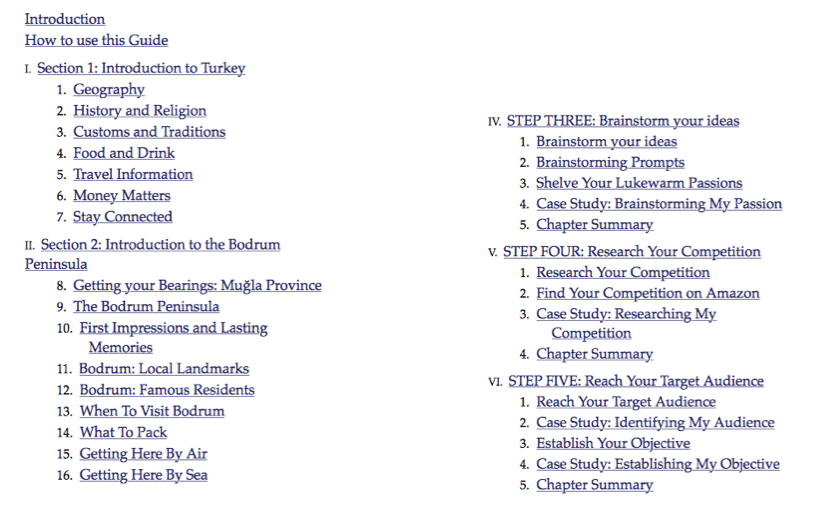
In these two examples above, I’ve used different methods for numbering the content. The travel guide example on the left uses continual chapter numbering. But in the how-to book example on the right, I used separate chapter numbering within each book part because I wanted the reader to see each of these steps as individual parts. I felt this would keep them from getting overwhelmed.
The placement of your table of contents is of pivotal importance. All pages before it don’t appear in your table, but all sections after it are included.
Foreword
- Optional
Somebody, other than the author, writes a foreword, and it can be used as a marketing opportunity when written by a reputable author or public figure in your niche. The role of this content is to add an air of authority or credibility to your topic.
As a beginning author, it can be intimidating to reach out to well-known people. Start early in your writing process to find potential contributors, and begin networking with them to build a connection ahead of your publication date. A Google search on your book’s topic should reveal writers and authors vocal in your niche. You can send them a synopsis and content scope, so they don’t have to read your entire book before committing.
Preface
- Optional
A preface is an opportunity to explain how a book idea transpired or why the topic is important to you. Here’s an example of the information I included in the preface of a few of my nonfiction books:
- In my How to Plan a Travel Guide, I wrote about a visit to the Los Angeles Travel show and how all the traditional publishers were investing in physical guide books. I summarized my journey to becoming a travel guide writer.
- In my How to Publish a Travel Guide, I wrote about my self-publishing journey and how I wanted to help other bloggers self-publish.
- In my A Turbulent Mind poetry collection about my mother’s dementia, I wrote about the poet who inspired my style, and why this book was intended for people who don’t like poetry.
In each example, the content provides the reader with a deeper understanding of why I wrote the book. If readers skip the preface altogether, it won’t impact their understanding or appreciation of the content. The critical thing to remember is not to include any essential content for your preface because it might not get read.
Acknowledgments
- Optional
Whereas your dedication is short and sweet, your acknowledgments page can include a much lengthier summary of all the people involved in your book. You can thank groups of people, or list everyone who had a hand in bringing your book to fruition, e.g., your editor, proofreader, friends, family, beta readers, fellow authors, etc. The list is endless. There’s a good chance your reader will skip this page if it’s too long, but it’s your opportunity to showcase everyone who has been part of your book project. Below, you can see an example of the acknowledgement in Alzheimer’s and Dementia Caregiving Stories Anthology.

Introduction
- Optional
A nonfiction introduction is useful for detailing out the scope and organization of your content. If you feel your reader would benefit from this explanation, don’t write a prologue, just focus on writing a useful introduction instead. In this day and age, where content creation seems to favor solving reader’s problems and challenges, your introduction is the best place to explain the benefit of reading your book as well as your content goals.
Prologue
- Omit
A prologue is for fiction books, so don’t include one in your nonfiction book. This bit of front matter provides an opening for a story that establishes the setting and gives background details. Generally, it tells some earlier story and connects it to the main story.
Half-Title Page
- Optional
If you have an extensive front-matter section, you can mark the official beginning of your book content by adding a half-title page. This page just includes your book title and sub-title. This is a visual cue to your reader that your front-matter has ended and your book has begun.
Keep Front Matter Simple
Don’t get overwhelmed with this list of front-matter pages. If you’re not sure whether or not to include one of the optional pages, err of the side of caution and leave it out.
If you have questions about how to professionally present your book’s front matter, leave me a comment below. And if you found this post useful, please share it!
About the Author
Jay Art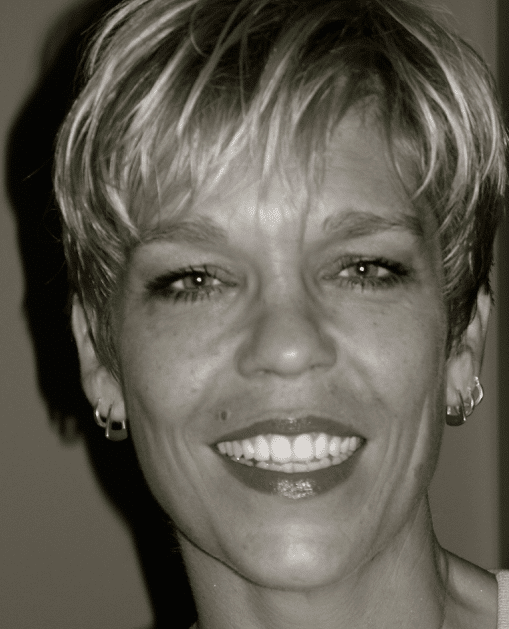 ale abandoned her corporate career to become a digital nomad and full-time writer. She’s an avid blogger and a nonfiction author helping travel writers and travel bloggers achieve their self-publishing goals. Join her at Birds of a Feather Press where she shares tips, advice, and inspiration to writers with an independent spirit.
ale abandoned her corporate career to become a digital nomad and full-time writer. She’s an avid blogger and a nonfiction author helping travel writers and travel bloggers achieve their self-publishing goals. Join her at Birds of a Feather Press where she shares tips, advice, and inspiration to writers with an independent spirit.
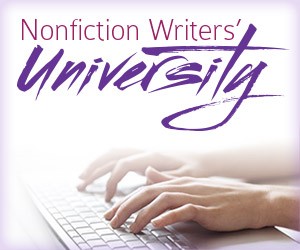 Would you like to write and publish nonfiction work, like articles, blog posts, books, or reports? Check out the Nonfiction Writers’ University. Get the basic education you need and the coaching to help you succeed as a nonfiction writer. Take advantage of monthly live educational and group coaching events. Enjoy a 30-day trial membership for only $1.
Would you like to write and publish nonfiction work, like articles, blog posts, books, or reports? Check out the Nonfiction Writers’ University. Get the basic education you need and the coaching to help you succeed as a nonfiction writer. Take advantage of monthly live educational and group coaching events. Enjoy a 30-day trial membership for only $1.
Do you want a more advanced approach to your nonfiction writing education? Join the Nonfiction Writers’ Univeristy MASTERS program. Receive ongoing live Certified High Performance Coaching, Author Training, and Authorprenuership Training as well as monthly educational and group coaching events. Learn all the steps to becoming a successful—and profitable—author. Discover how (finally) to write consistently, boldly, enthusiastically, and productively. Develop the mindsets, strategies, habits of the world’s most successful writers. Click here to learn more.
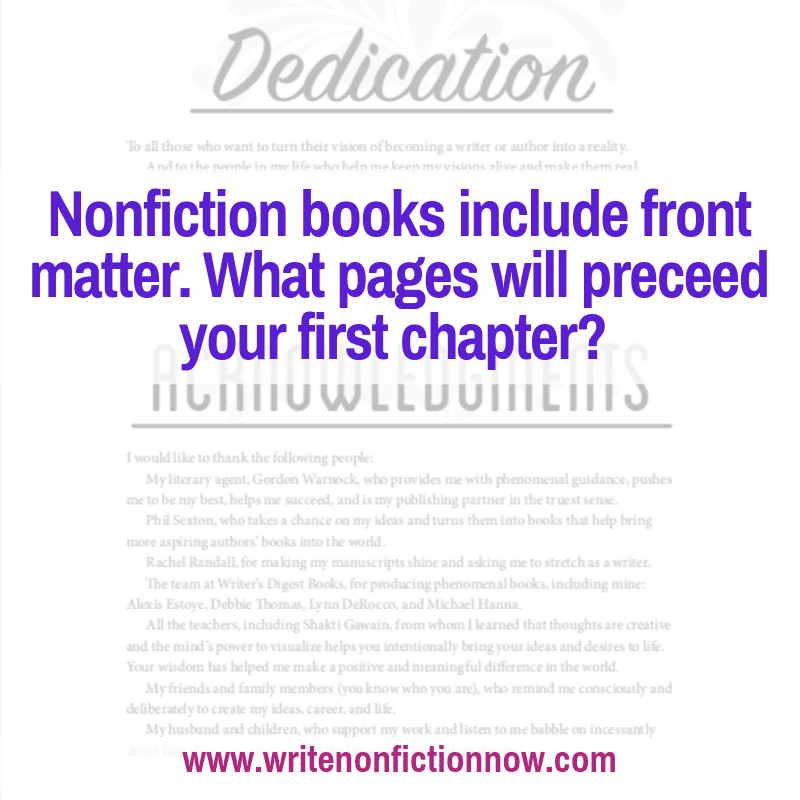
Renee says
Comprehensive and helpful.
Thanks
Cathy Turney says
Very helpful, Nina! So much writer help is oriented to fiction and memoir. You are the crusader for nonfiction writers!Thank you!
Nina Amir says
Thanks, Cathy! You rock!
Robert S says
Where does the “About the Author” page go?
Nina Amir says
Usually at the back of the book. Or on the inside flap of a back cover–if the book is hardcover.
Jay Artale says
Glad you found it useful Renee.
Jay Artale says
Hi Cathy … glad the content helped you out. Even though there’s lots of overlap between fiction and nonfiction, it’s important there are platforms to share content that focuses specifically on nonfiction writing and publishing. It’s great to be part of the crusade.
Jay Artale says
Hi Robert … when writing nonfiction, the front of your book needs to be focused on your reader and their needs, so it’s best to have your About the Author section at the back of your ebook and paperback. But, you can use the Preface to include an overview of your experience and subject matter expertise, so that you’re giving the reader confirmation of why you’re the best person to write your book.
Minal says
Hi Nina,
I am planning to write a book on Covid-19. Please suggest some tips and what all to include in book design?
Nina Amir says
Go to The Book Designer for design help.
LaToya Jones says
Thank you so much for this information! I’ve searched for instruction and could not find just what I was looking for anywhere. Your content was clear, understandable, and very helpful to one as me, a beginner writer.
Nina Amir says
So glad you found it helpful!
Simon Braund says
Hello, Jay. Excellent post. Could you give me some guidance on how to format a nonfiction title page (font size, alignment etc)? Also, should each element of front matter be on a seperate page?
All best, Simon
Alison says
Thanks for this! This is really helpful information. Trying to format my print version today and it’s more complicated than I thought!